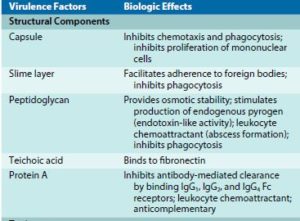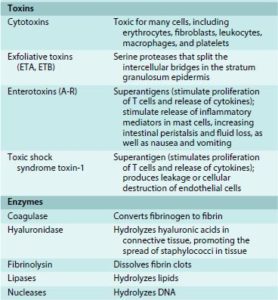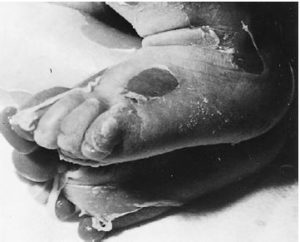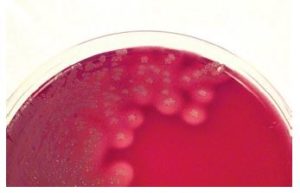Staphylococcus aureus – Epidemiology, Pathogenesis & Treatment
Introduction
- The genus name Staphylococcus refers to the gram-positive cocci that grow in a pattern resembling a cluster of grapes.
- The cell wall of staphylococci is rich in peptidoglycan similar to a typical gram-positive cell wall.
- Have ribitol-teichoic acid interspersing the peptidoglycan molecules.
- Have antigenic property.
- Other than peptidoglycan, surface proteins such as protein A are present.
- It uniquely binds to the Fc portion of the IgG antibody, and the antigen reacting Fab region is left externally. which interferes in the process of opsonization.
- On blood agar, S. aureus forms white color colonies, which later turn into golden in color.
- Most strains show hemolysis.
- Coagulase Positive (S. aureus).

Toxins & Enzymes of virulent S. aureus
α-Toxin
-
- These proteins are secreted by all staphylococcal strains, the exception is coagulase-negative ones.
- It gets inserted in the lipid bilayer and forms pores which cause lysis of cytoplasmic membranes,
- It leads to cell death.
Exfoliatin
- The skin epidermal layer has intercellular junctions, exfoliatin disrupts these junctions splitting the epidermis between stratum granulosum & stratum spinosum.
Pyrogenic Toxin Superantigens (PTSAgs)
- These secreted proteins produced by staphylococci trigger systemic symptomatic effects.
- Strongly mitogenic (protein inducing mitosis) for T cells.
- They associate themselves with MHC II molecules, externally and show specificity for T cell’s V β region.
- It triggers the large production of cytokines such as interleukins-1, and tumor necrosis factors by T cells & macrophages.
Staphylococcal Enterotoxins
- It targets the gastrointestinal tract and induces related symptoms such as vomiting.
- Several antigenically variants are known such as enterotoxin A, B, C; they are low molecular weight proteins.
- Toxins are stable even after getting exposed to acidic gastric & jejunal enzymes and also even after boiling.
- They directly act on neural receptors present in the upper gastrointestinal tract, leads to vomiting.
Toxic Shock Syndrome Toxins
- It’s a leading cause of staphylococcal toxic shock syndrome, and its properties are very similar to staphylococcal enterotoxins.
- Triggers the release of the cytokines, here superantigens mechanisms are involved.
- It also causes hypotension, capillary leakage & shock.

Epidemiology
- S. aureus is a common microorganism present in normal human microbiota of the skin, nasal carriers.
- They are opportunistic pathogens.
- Community outbreaks are usually seen where there is poor hygiene maintained, even fomite transmissions between individuals are the source of infection.
- Even nosocomial infections are recurrent can be spread from hospital personnel.
Pathogenesis
Primary Infection
- Colonization is mediated by surface proteins, which binds to the host elements, which can be tissues or foreign parts like catheters.
- Proteins bind to collagen, fibronectin & fibrinogens.
- The initiation of infection is induced by any trauma, foreign matter.
- There are some factors such as protein A that interfere in phagocytosis.
- It binds to the Fc region of IgG, competes with phagocytes, by which opsonization is interrupted.
- Coagulase production, retard the migration of the phagocytic cells & lysosomal killing is resisted.
- The lesion is formed due to an acute inflammatory response. or maybe due to fibrotic reactions of the host cells to the toxins.
- The process depends on localization by the host which varies with tissues involved.
- On the skin, it may appear as a boil which may include fibrosis & granulation.
- On other organs such as lungs, kidneys, it may spread with a small focus area then may involve broad areas.
- Cytotoxins involved are more destructive, which causes massive necrosis.
- In severe cases, infections may enter the bloodstream and cause more damage.
- Organisms may shed its component, which leads to massive complement activation, septic shock syndrome, leukopenia.
Toxin-mediated disease
- The primary infection serves as the initial site of toxin absorption.
- As it is seen in staphylococcal food poisoning, pyrogenic exotoxins are the cause of illness rather than the microorganisms involved.
- The exfoliative toxin, cause blister-like epidermal separation, localized at the skin region.
- In Staphylococcal scalded skin syndrome, it is caused by a toxin, by which epithelial desquamation occurs.
- In Staphylococcal, TSS (Toxic Shock Syndrome), is a pyrogenic exotoxin TSST-1, which stimulates the release of superantigen-mediated cytokine. e.g., Menstruation related TSS, a combined effect of menstruation and high absorbing tampon, which favors the growth of staphylococci and toxin production is enhanced.
Manifestations of Clinical Diseases caused by Staphylococci
| Disease | Manifestations |
| Primary Infections | |
| Furuncle and Carbuncle |
|
| Chronic Furunculosis |
|
| Impetigo |
|
| Deep Lesions |
|
| Toxin mediated disease | |
| Scalded Skin Syndrome |
|
| Toxic Shock Syndrome |
|
| Staphylococcal Food Poisoning |
|


Diagnosis
- Pyogenic infections by staphylococcal can be detected by microscopy.
- In nonselective media, S. aureus grows rapidly, but to obtain this microorganisms from the contaminated specimens, mannitol salt agar is used, which is a selective media.
- Even blood agar can be used for isolation of S. aureus.

- Catalase & Coagulase tests.
- Nucleic Acid Detection.
- Antibody Detection.
Treatment, Prevention, and Control
- Localized skin infection is managed by minor incision & drainage.
- Oral Therapy includes doxycycline, minocycline, trimethoprim-sulfamethoxazole, vancomycin (intravenous therapy).
- Proper cleaning of the infected wounds by disinfectants.
- Hand Washing & covering exposed wounds are preventative measures that can be followed.
References and Sources
- https://www.researchgate.net/publication/11386423_Staphylococcal_Exfoliative_Toxin_B_Specifically_Cleaves_
Desmoglein_1 - https://acikders.ankara.edu.tr/mod/resource/view.php?id=59091
- https://www.researchgate.net/publication/14643895_Localization_of_biologically_important_regions_on_toxic
_shock_syndrome_toxin - https://microbenotes.com/staphylococcus-epidermidis/
- https://www.ncbi.nlm.nih.gov/books/NBK8477/
- http://www.textbookofbacteriology.net/staph.html
- https://www.ncbi.nlm.nih.gov/pmc/articles/PMC2923430/
Also Read:
- Food Intoxication caused by Staphylococcus aureus
- Salmonella-Epidemiology, Pathogenesis, Diseases, and Treatment
- Toxins-Introduction, Types and Mechanisms
- Botulism- Etiology, Pathogenesis, Treatment and Prevention
- Pseudomonas aeruginosa-Etiology, Pathogenesis and Treatment
- Tetanus – Etiology, Pathogenesis, and Treatment
- Mycobacterium tuberculosis-Epidemiology, Pathogenesis, and Treatment
